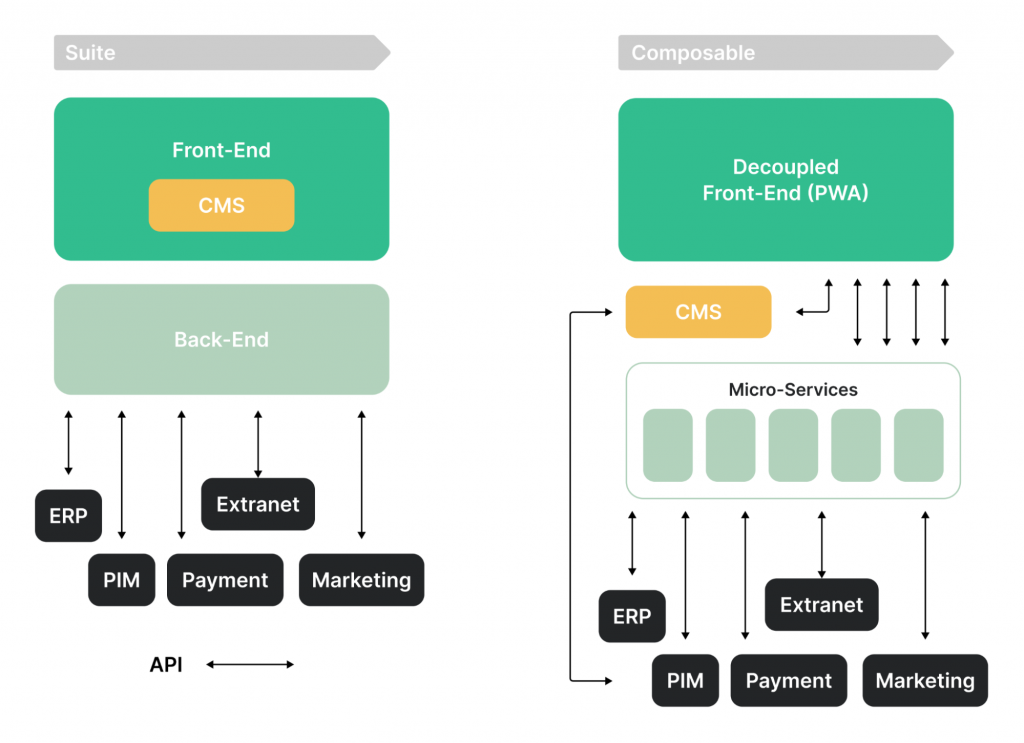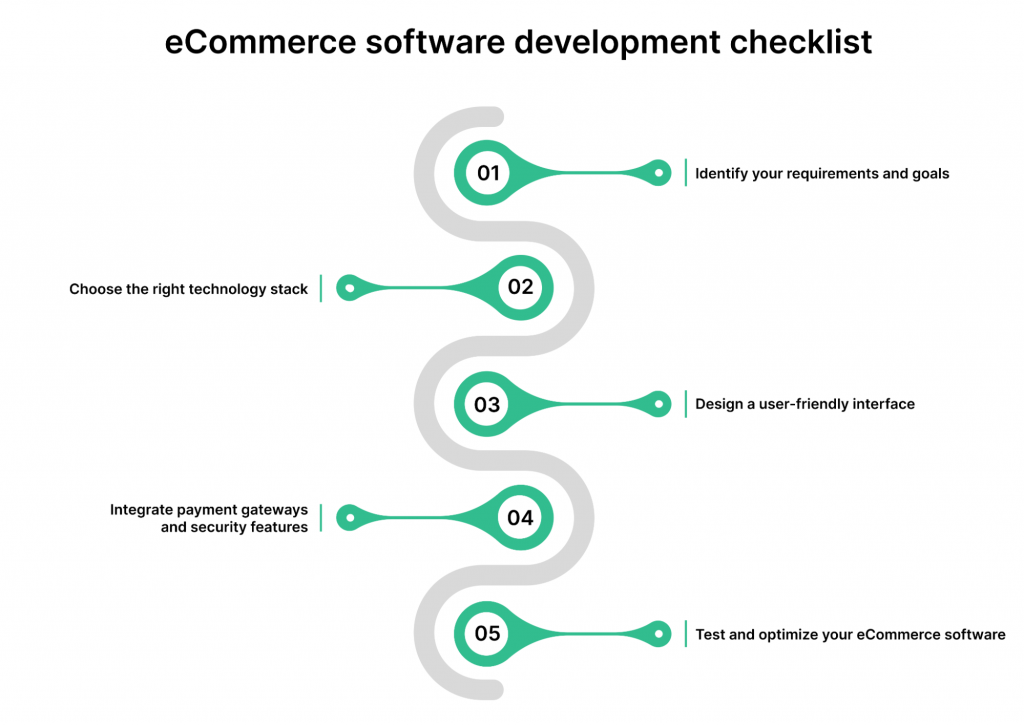The next wave of eCommerce innovation is here. Is your business ready to get a competitive edge with best-of-breed custom software?
In just two short years, the game-changing world of online shopping is set to be transformed yet again. The upcoming advancements in eCommerce software development will take the shopping experience to new heights. So, it’s the right time to surf up and drive eCommerce revenue using the software as a force.
Read on to explore what to expect from online shopping in 2023 and what steps to take to create cutting-edge eCommerce technology products.
Staying Ahead of the Curve: Essential eCommerce Software Development Trends to Watch
Composable architecture
More and more big fishes in the eCommerce business strive to break their monolithic architecture and decouple the frontend from the backend. This phenomenon has a weird name, “headless.” Despite its obvious complexity, it helps webstores work on the shopping experience and improve the backend part without any dependencies. Well, it’s an excellent point for eCommerce since it can retain customers and enhance offering step-by-step.
Meantime, composable architecture is a broader category allowing companies to compose various ready-to-use solutions from well-known vendors and create a custom-like stack from proven SaaS. This approach delivers the flexibility desired, drives dev velocity, and helps scale up effortlessly.

Composable architecture is also possible with custom eCommerce software development of frontend platform, CMS or other components. If you have a robust product for modernization – there’s no need to jump to an entirely new tool. You can go composable in any case. Your desire and relevant business conditions are all you need.
Looking for experts to simplify the eCommerce software development process? Check up on what the IDAP team can do to help you design robust modern products at a fraction of the cost.
AI & ML
Did you see what modern web stores are capable of? They struggle to deliver a smooth and stellar shopping experience to each consumer, and technologies like artificial intelligence (AI) and machine learning (ML) are their allies in this process. In 2023, we can expect to see even more eCommerce platforms using AI to analyze customer data and offer personalized recommendations based on past purchases and browsing history. This technology will also be used to optimize product search and recommendations, making it easier for customers to find the products they seek.
Related: Machine Learning vs Artificial Intelligence vs Deep Learning
Voice commerce
A new game-changer is on the stage. This year, you’ll hear even more about voice-activated shopping since its popularity is growing dramatically. As voice assistants become more ubiquitous in homes and businesses, eCommerce platforms will likely integrate with these systems, allowing customers to make purchases simply by speaking a command. This technology will rely on natural language processing and machine learning algorithms to accurately interpret the customer’s voice commands and provide appropriate responses.

Blockchain
Security comes first. This motto is promoted by governments and their various data protection acts by setting up strict requirements and super-high penalties for breaching. Blockchain technology is capable of helping businesses handle terabytes of sensitive data collected and ensure their security. The same goes for online transactions since the technology prevents fraud and disputes. Blockchain technology may be used to develop decentralized marketplaces where buyers and sellers can transact with each other directly without the need for intermediaries.
Related: Blockchain technology in plain English
AR/VR
Recently I was impressed by the AR shop Serendipity on the beach, demonstrating the wonders of technology and its impact on eCommerce sales, of course. The relevant TikTok video became viral.
In 2023, we expect more eCommerce platforms using AR and VR technologies to create immersive customer shopping experiences. AR and VR allow customers to try on clothes virtually, visualize how furniture would look in their home, or see how a product works in real-time.
How to develop eCommerce software from scratch in 2023: must-have steps
The world of eCommerce is booming, and the demand for online shopping continues to grow. Building your eCommerce software from scratch can be an excellent solution if you’re thinking about boosting your online business. However, building a new product can be daunting and challenging, especially when new technologies and trends are rapidly emerging. Meantime, we collected several must-have steps you should perform to make the task easier and build the robust eCommerce software of your choice at a fraction of the cost and time.
Related: Custom App Development Cost [Update 2023]
Identify your requirements and goals
Before developing your eCommerce software, you need to identify your requirements and goals. What software should it be? A payment system, a backend platform, or CMS? It’s crucial because, in some cases, you can easily buy ready-to-use solutions and solve your business issues. Meanwhile, sometimes custom software definitely works better. Check our latest success story about the SweetSpot store for the shining example of custom eCommerce software performance.
Choose the right technology stack
The appropriate tech stack is half of software project success. Opt for technologies that can handle the increasing demands of online shopping. You should consider factors such as:
- scalability
- security
- performance
- cost-effectiveness
Popular eCommerce technology stacks include React.js, Angular, Vue.js, Node.js, Ruby on Rails, and PHP.
Related: What is the Best Language for Mobile App Development
Design a user-friendly interface
Storefront is a starting point of the customer journey, so your business performance and revenue directly depend on the frontend you offer. To remain competitive, you need to design a user-friendly interface to deliver a seamless and enjoyable shopping experience. Your interface should be responsive, intuitive, and visually appealing. You should also consider incorporating features such as chatbots, voice search, and personalized recommendations.
Integrate payment gateways and security features
Integrating payment gateways and security features are crucial for any eCommerce software. You need to ensure that your payment gateways are secure and reliable. Incorporate security features such as SSL certificates, two-factor authentication, and encryption to protect your customers’ sensitive information and comply with legislation.
Test and optimize your eCommerce software
Last but not least – testing. You need to check up on the prototype created to make sure the solution meets your requirements and goals. Collect the feedback, and keep mistakes in mind to optimize the product and boost its performance. You can use tools such as Google Analytics to track user behavior and identify areas for improvement.

Related: About Software Outsourcing Market in 2023: Technologies, Pitfalls, and Solutions
Summary
Are you want to start eCommerce software solution development from scratch? Don’t let minor mistakes cost your audience and risk falling behind the latest technology trends. But don’t worry. You don’t have to do it alone! Partnering with a third-party expert with a solid background can help eliminate risks and fast-track your time-to-market. And that’s where the IDAP team comes in! Our team of experienced professionals can turn your eCommerce idea into a reality that not only meets but exceeds your expectations. Don’t wait any longer to revamp your eCommerce game – contact our sales team, and let’s get started!



